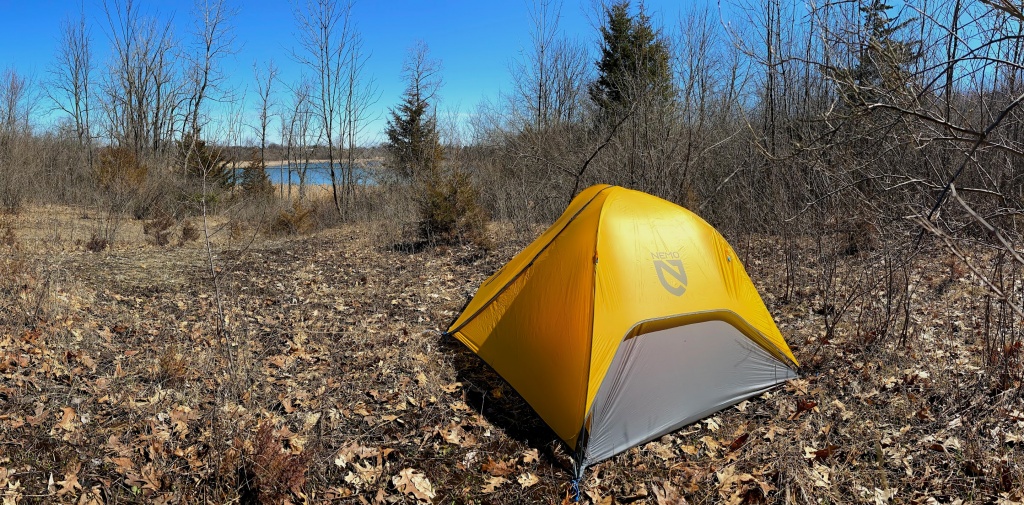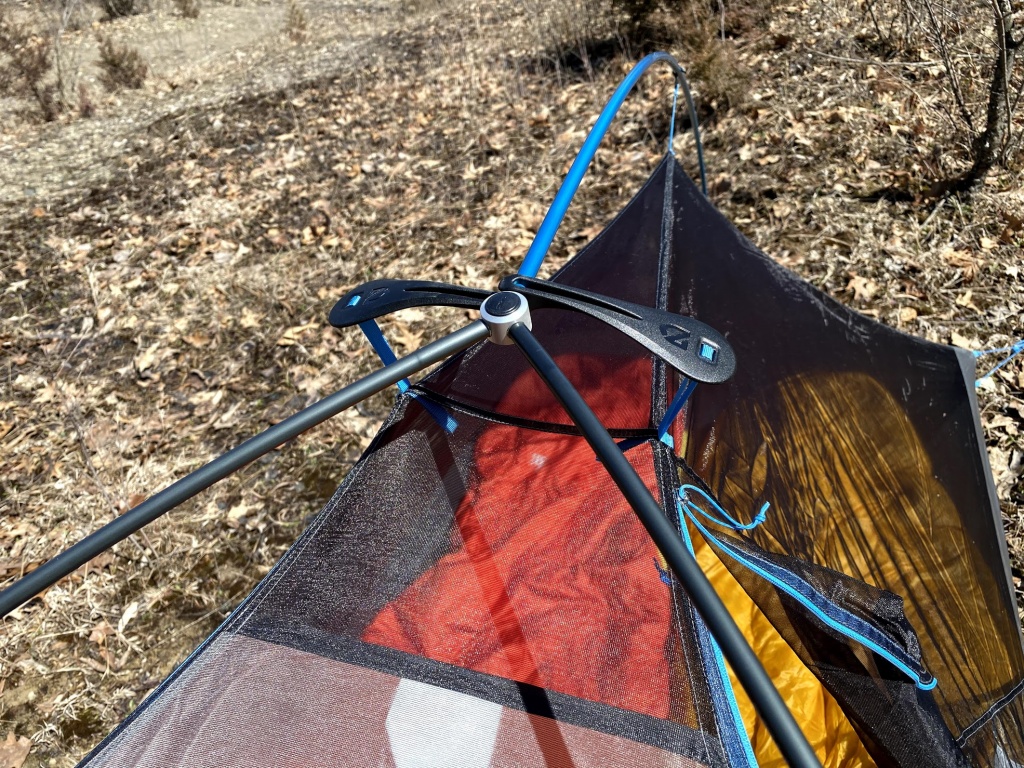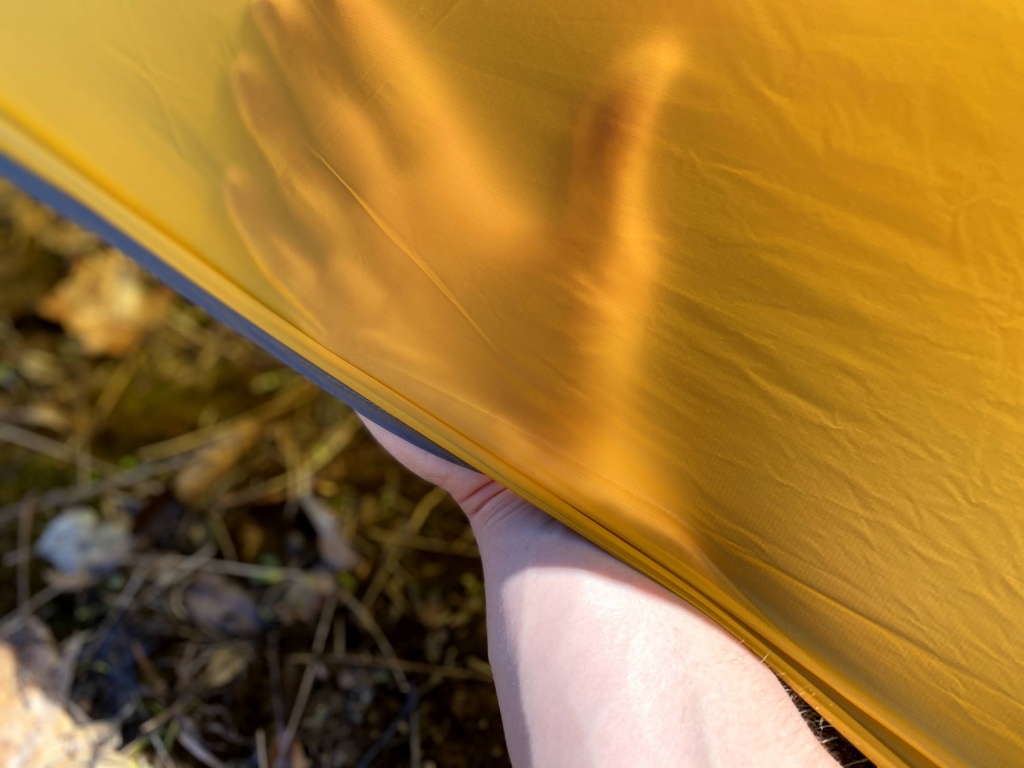NEMO Hornet Elite 2 Review
Our Verdict
Our Analysis and Test Results
Nemo updated the Hornet Elite with their proprietary new Osmo fabric. The new model, the Hornet Elite Osmo, has a couple new features like an updated stuff sack and redesigned door tie-backs. The major update is in the Osmo material, which is designed to have longer lasting water repellency and to stretch and sag less when it gets wet. The Osmo fabric is also recycled and made without PFCs or PFAs. Above you can compare the two tents — on the left is the Hornet Elite we tested, followed by the Hornet Elite Osmo, right.
This tent is barely over two pounds (including stakes and guyline). It goes all-in on minimizing weight but also tries to maintain some creature comforts like two side doors and vestibules.
Performance Comparison
Comfort
The bottom line is that this tent is great for one person and tight for two. The two side doors go a long way in making a tent this size feel roomier. The interior dimensions, 85 inches long, 50 inches wide (tapering to 42 inches at the foot), definitely feel snug with a second person. The lower sidewalls creep in a bit, limiting space at abdomen height. One unique feature of this tent is the flybar at the top which is meant to perform the same function as a cross pole in a traditional tent by maximizing peak height volume. It increases space at the ceiling, and for one person looking to carry the whole tent, it's adequate and an impressive innovation. However, with two people trying to sit up at the same time, the 37 inch peak height still means your head will press against the mesh ceiling.
Keeping with the minimalist design, each side comes with a gear storage pocket sufficient for a phone, deck of cards, or pair of gloves (or any other small items you want to keep close at hand). There is also a headlamp storage pocket at the top that is made of opaque white fabric, which diffuses the light nicely at nighttime.
Weather Resistance
This tent is impressive given how few pieces it actually has. It is really simple to get a good, taut pitch with both the tent and the fly, which gave us that much more peace of mind when the rain moved in. The fly runs low and tight to the ground, which minimizes splashback. Though the area of the vestibules is a scant 6(+) square feet each, it was still nice to know that our boots were protected, even if a few backpack straps still stuck out.
The downside of this tent is its lack of rigidity in high wind. It only has a few pole segments, so even if you stake it out as thoroughly as you possibly can, the spine of the pole structure still wobbles and flexes in the wind.
Weight
This tent is an all-star when it comes to weight. In fact, when you consider the entire package (tent, fly, poles, and stakes), it is one of the very lightest (semi)-freestanding tents around. All in it is just over two pounds. This increases its versatility quite a bit, making it a super lightweight option for two people to split up (as long as you don't mind being really cozy with that person at night), or a roomier tent for one person, still carrying a very reasonable load.
There's really nothing bad to say about it. There are tradeoffs for having a tent this light, which are discussed in this review. It's heavier than many ultralight tarp shelters, but as far as dedicated-pole, double-wall tents go, this one is as light as it gets.
Durability
You do need to take care with the Hornet Elite. The fly, tent floor, and mesh are all susceptible to puncturing more than is typical. Over the course of testing, we noticed that the floor started to develop little pin holes where rough soil and sand had been rubbing at night.
One of the nice things, however, is that there are so few pole segments and only one point of intersection at the pinnacle that it is less likely you will snap one of them (though the tent does come with a repair splint if you do). However, delicate materials aside, we found the construction quality to be excellent and never had an issue with broken zippers or bent stakes, as is so often a problem.
Ease of Set Up
Owing to its limited number of parts, this tent is one of the easiest to pitch. The Y-shaped pole structure and webbing on the clips are color-coded to make it even easier to ensure everything is oriented correctly. The tent uses unique slide-and-lock grommets that make it quick and simple to insert and secure the pole ends to the tent. The fly then loops onto the same stakes as the tent corners and also has one stake point for each of the two vestibules.
Taking this tent down is just as simple. We appreciate the reflective cord attached to each stake, which makes it easier to spot in the dark or if it's just driven deep into the dirt. One person can easily pitch and break down the tent in a couple of minutes.
Packed Size
This goes hand-in-hand with weight, but this tent packs down very tightly as well. Its 10D floor and 7D fly fabric both feel a little like tissue paper. Both parts are thin enough that you could stuff one each into a water bottle pocket if you wanted to.
The pole segments are similarly minimalist. We typically carried them either in one of our deeper water bottle pockets, secured with a strap, or just slid them vertically down the side of our packs. We also appreciate NEMO's divvy sack, which has a drawcord at its midsection that allows you to separate a soggy fly from the rest of the tent if it hasn't had time to dry out before you get moving.
Value
We think that this tent has moderate value. There are other comparable, slightly less expensive options out there. It is pricey, but also requires care each and every time you pitch it. However, if you are committed to a long-distance trip and are already inclined to baby your gear, it certainly won't disappoint.
Conclusion
The NEMO Hornet Elite is excellent for those who are planning a long-distance and/or lightweight adventure and don't mind sacrificing some interior space to shave ounces from their pack. It has its drawbacks, but all in all, we like this tent.
















